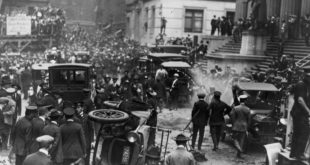Publisher’s note: This article includes a photo of former SOF managing editor Bob Poos, who was a war correspondent in Vietnam. ~SKK
by Marvin J. Wolf, The War Horse
I steered the Jeep off the dusty, rutted main road and rattled down a well-worn track until I beheld a bizarre juxtaposition of images: the silhouette of a thousand-year-old Hindu temple cheek by jowl with something resembling a porcupine dozing on a glass box: an air traffic control tower bristling with radio antennae.
Standing nearby, as expected, was a 30ish man, perspiration staining the armpits of his blue suit, a wilted tie drooping across a damp shirt that had until recently been starched and white. A few minutes of morning sun had turned his face and neck bright red. He wore checked socks and new penny loafers that looked like they might come apart at the seams momentarily.
A reporter for one of the larger Midwest dailies, he’d arrived in Vietnam so recently that he was still peeing stateside water. At his first Saigon stop, the Associated Press office, he’d received a brief orientation.
“Get over to the Joint U.S. Public Affairs Office for press credentials, then go back to the airport and get up to An Khe—the First Air Cav. When you get there, find a little sergeant in the PIO section, name’s Wolf, and ask him for field gear—you can’t cover this war dressed like you were reporting school board meetings. Bring him a couple of bottles of bourbon and some Kodak 35mm film. Oh, and his boss will probably point you at a good story.”
Such was my repute in certain circles, and such was Maj. Charles Siler’s, that by 1966, almost every newbie reporter made An Khe their first stop out of Saigon.
Siler had the contacts and the inside stories. I had the goods: rubber-soled canvas boots that dried on your feet instead of rotting off them. Lightweight jungle fatigues. Ponchos, canteens, steel helmets, and sometimes a flak vest or a poncho liner. The essentials. I didn’t set out to be in nonprofit black market supply. But it would never have happened had I not met Henry a few weeks before we left for Vietnam—a skinny, sallow-skinned, worried-looking private first class.
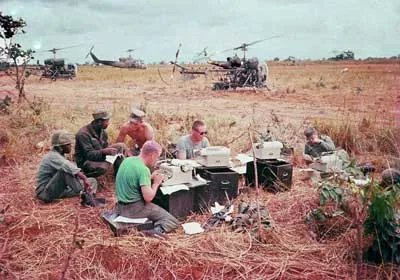
Gentlemen of the press interview troops, write news copy, and edit their work at a hastily assembled minimalist, open-air press center alongside an Air Cav landing zone in South Vietnam’s Central Highlands in early 1966. Photos by Marvin J. Wolf.
He hitched a ride with me from Fort Bragg back to Fort Benning, then asked me to detour 300 miles out of the way. It’s a long story, so for now let’s just say that I did his family a huge favor. He owed me—not only money but for something money couldn’t buy. Three months after that, I was plodding along a muddy road in a driving monsoon when a deuce-and-a-half came careening around a bend, fishtailing and spraying muddy water every which way.
As the truck went by the driver honked, then stopped.
When I’d wiped my eyes I saw Henry behind the wheel, grinning like the Cheshire Cat and terribly pleased to see me.
“Get in,” he said.
He was the right-hand man to a brigade supply sergeant, an alcoholic who daily put back a fifth of whiskey by noon. He’d take a nap until dinner time, then resume drinking. When he couldn’t get whiskey, he’d drink gin, vodka, even wine—whatever he could lay lips on. Juiced he was malleable, sober a nasty dick. Henry did whatever he could to keep him toasty. Henry ran the supply room, forging the noncom’s signature to requisitions, keeping things running smoothly and the Army off the sergeant’s back.
Henry and I made a pact: I would supply him with booze, and he would give me anything that a brigade supply room could requisition, which was pretty much any expendable you could think of.
Getting the booze was easy once I’d explained the deal to Siler. I collected all the ration cards in the section, got an enormous mailbag, and with travel orders in my pocket and a list of other errands to be run, flew down to Saigon. At the Caravelle Hotel, ABC’s bureau chief gave me his extra room for the night. I borrowed an armload of towels from a housekeeper’s cart and caught a cyclo, a local pedicab, to the PX class VI store, which stocked almost every known type of alcoholic beverage. I made several trips through, choosing a different cashier each time and buying bourbon till I ran out of ration coupons and the $100 that Siler fronted.
I put each bottle in a thick towel wrapped tightly with green duct tape, then filled and sealed the mailbag. Nobody screwed with a mailbag; I might have hauled a corpse in one.
Back at An Khe, I gave Henry a bottle or two every few days, then created a storage area behind a false wall in the public information office tent. And when reporters—or section newcomers—needed a pair of jungle boots, a canteen, or anything at all, I took them to my secret store.
Within weeks the word went around the newsies grapevine, and a steady trickle of newcomer reporters dropped into our tiny public information shop. The First Cavalry got tons of publicity—we usually had something interesting going on, or about to.
We trained our visitors to contribute in the coin of the alcoholic’s realm. Did I mention that because there was no liquor tax in the PX system, a bottle of Jack Daniels Black went for $1.15?
This was not the only purpose to which the fruits of the class VI store were put. I returned to base camp after several days in the field and found that we had a new three-quarter-ton truck to haul tents and gear, not to mention the reporters who flocked in to cover big combat operations. It had long been apparent that we needed such a vehicle, but we were not authorized one.
So no truck—until one magically appeared. When I asked about it, Sgt. 1st Class McGinnis, the tall, crusty regular whose job revolved around keeping the paperwork straight and making sure we free spirits of pen and lens observed just enough military discipline to stay out of jail, shrugged. As far as he knew, that vehicle just turned up. Maybe, he opined, it came from some secret equipment depot.
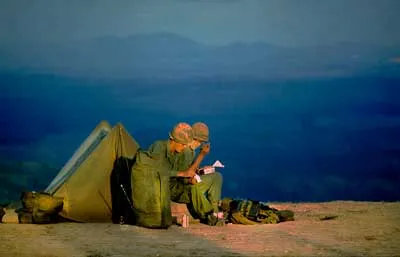
Troopers of the First Battalion 12th Cavalry take a few spare moments to read letters from home.
A few weeks later the mystery was solved. One of the guys told me that Mac had walked over to a nearby Special Forces camp and made friends. A deal was arranged. The Green Berets took their most decrepit three-quarter into the jungle, carefully shot holes in its windows, doors, hood, and other noncritical parts with a captured AK-47, then photographed their handiwork before writing it off as a combat loss and requisitioning a new one.
Mac produced a case of bourbon and drove the still very functional truck to another pal in the division ordnance battalion. More amber bottles changed hands, and a week later we had a completely reconditioned truck: A log book “proved” that this vehicle had come with us from the States, a “permanent loan” from some since redesignated unit. Years hence, when the cav returned stateside, someone might have to explain where that vehicle came from. But it wouldn’t be Mac’s problem.
All this might lead you to suppose that the Army’s supply system was screwed up, and you wouldn’t be totally wrong. But let’s give credit where it’s due: Long before 1965, those who ran the U.S. Army certainly knew that not only, as the famous dictum attributed to Napoleon had it, “an army travels on its stomach,” but also that a modern, mechanized army is utterly dependent on logistics. And with our hundreds of aircraft, none were more so than the First Air Cav.
Vietnam’s Central Highlands is nearly as far from the states as it’s possible to get. Everything we needed to survive, to fight, and to win had to come through the longest supply line in the world: food, ammunition, fuel, spare parts, toilet paper, penicillin, individual clothing, entrenching tools, canteens, steel helmets, boots, uniforms—all that and much more was shipped or flown in.
The basis of an organization’s authority to requisition supplies is its Table of Organization and Equipment, a lengthy, detailed document that spells out what each section or squad, platoon, company, troop, battalion, or brigade—every unit—is authorized to have in the way of people and hardware.
The Army’s vast, computer-equipped logistical network was built to ensure that everything needed was available when required, that as equipment wore out or was lost in combat, it was repaired or replaced, and as stocks of expendables were used up, they would be replenished.
And most of the time, it worked. But not always. Because the one thing that the Army supply system ignored was human nature.
Take, for example, the floodlight battle. Our base was encircled with hundreds of miles of coiled concertina—great loops of stainless steel wire festooned with razor-sharp barbs. Behind that was another fence, and around this inner barrier, at intervals, were guard towers. Nevertheless, the enemy had sappers, combat engineers who were capable of cutting through or tunneling under our wire. One deterrent to that sort of night attack was flood lights to keep the wire constantly illuminated. But we had no floodlights. Instead, we had mortars on standby with illumination rounds—flares suspended beneath parachutes. At the slightest alarm, men in the towers could call for illumination. Usually, they could get it within two or three minutes. In three minutes, Viet Cong sappers could blow a hole in that wire. In fact, they did that more than once, usually while staging a diversionary attack elsewhere.
Several times our supply mavens requisitioned flood light systems. Months passed; the lights never showed up. Finally, a major was sent to investigate. He tracked the most recent requisition through every stop on its circuitous route from the factory—and found it emplaced around the perimeter of a U.S. Navy base less than 50 miles away. When our commanding general complained to the admiral commanding that installation, he was informed that as the admiral’s date of rank was earlier, the lights would remain in the Navy.
More lights were requisitioned. More months passed.
Then there was the matter of TO&E’s written by people who failed to understand a unit’s mission, either because they were ignorant of it or because the unit’s mission expanded or was refocused. Take me, for example. Maj. Siler fought tooth and nail to pry me out of an infantry battalion rifle platoon where I was (pretending to be) a photographer because he knew, from years of experience as a division public information officer, that he needed good pictures to support the PIO mission of informing the public of newsworthy activities.
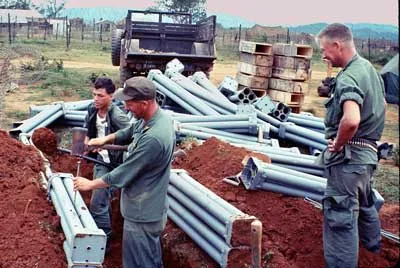
Associated Press reporter Bob Poos (right) observes men of Air Cav PIO section building a press bunker. Within minutes he was helping with the construction.
The Army didn’t see it that way. Nearly since Matthew Brady’s time, photography was the province of the Army Signal Corps. When Siler needed photos, he was obliged to submit a request to the Division Signal Battalion. In due course, the photo section would get it and, probably, dispatch a photographer. If they had one, and if he wasn’t on another mission, such as assisting accident or criminal investigations, making ID photos, or one of the other photo jobs that come up in a division of 15,000 men.
Even so, that system worked well enough when what was needed was a picture of somebody reenlisting, getting promoted, or receiving a medal. Such ceremonies are generally scheduled well in advance. It didn’t work so well if a PIO reporter in the field saw something visually important or arresting but ephemeral—like an infantry platoon in a skirmish line assaulting a Viet Cong stronghold across a rice paddy. Or a long skein of helicopters descending in a spiral to land in a meadow. Or any of a million other fascinating sights that illuminated Air Cav-style warfare but presented themselves only momentarily. For that he needed a photographer in the field, looking for such images, ready to capture those Army Kodak moments.
The Signal battalion lacked sufficient resources to detail even one photographer to the PIO. That’s why Siler needed me. But his TO&E did not authorize a photographer. That’s why I was officially not a photographer but an information specialist.
Change the TO&E? Sure, marginally less difficult than amending the U.S. Constitution and would take almost as long. So Siler did what any smart leader would do. He got temporary authorization for a few extra bodies and used them as needed. But whatever my job title, I needed a camera; when the two ancient authorized Speed Graphics were hors de combat I began using my own, which required 35mm film. There was 35mm film in the supply system, of course, but we were not authorized to requisition it because we were not authorized a 35mm camera.
So, amber bottles in hand, we made contact with Signal Corps units that could requisition 35mm film and other photo supplies. And discovered, post-swapping, that nearly all of the film, photo paper, and chemicals in the Army supply system were the ANSCO (later GAF) brand manufactured by General Aniline and Film Corporation, once a subsidiary of the I.G. Farben company. A vast, diversified chemical and dye manufacturer headquartered in Germany, Farben was co-opted by the Nazis. In 1941 the U.S. government seized the company as enemy property and put Americans in charge of redirecting its activities to support the war effort.
Naturally, if the federal government owns a company that makes products consumed by its own agencies, it seems to make sense to buy from them instead of from privately owned, for-profit firms. Or does it? Our friends in Signal Corps photo sections were glad to get our whiskey, which they promptly traded for Kodak film. Because they knew that virtually every roll of ANSCO film in the system had been manufactured years earlier. It was film that left the States in steel shipping containers that baked in the tropical sun for months before being unloaded. Cooked, it was next to useless. So we traded gear from Henry’s Third Brigade supply room to visiting newsies for whiskey and film and begged a few rolls of Kodak from others returning to Saigon, where they could get plenty more.
But there were things we needed even more than film. To help get them, Siler found a staff sergeant, a scrawny, 30ish man wise beyond his years, whom I will here call Lightfingers Bill. He was unofficially the section scrounger. He seemed to know where and how to get anything we needed.
For instance, he scared up two 55-gallon diesel drums, found someone with an acetylene torch to cut them in half, and scoured the insides with riverbank sand to remove the oily residue. Then he found a roll of thick green plastic sheeting that everyone called “membrane.” Engineers used it to seal out ground moisture under the airfield runway and in sandbag bunkers.
Two-by-fours were hammered into a frame over a four-foot hole filled with gravel requisitioned one midnight from a pile alongside the road. We chipped in to buy bamboo mats for walls; the membrane was cut in two: One piece covered the floor and the other became a shower curtain. A drain grill and a shower head on a pipe mysteriously materialized and were attached to the floor and ceiling, respectively. The barrel halves were welded together atop this makeshift structure, connected near their bottoms by short lengths of pipe.
And so the An Khe Mortar Lodge, as we called our little tent complex, got its own shower. Every few days a water trailer replenished the barrels with clean water. Then someone had a bright idea and we covered recycled C-ration cases with aluminum foil to reflect sunlight on the barrels; just like that we had a solar-heated shower. For cloudy days Bill found a diesel immersion heater of the sort in a field mess. Most of Bill’s scrounging went toward improving our standard of living from barely beyond jungle animals to something almost approximating boys’ summer camp with unscheduled mortar attacks.
Just before shoving off for Vietnam, Siler had bought a battered but serviceable refrigerator at a Fort Benning thrift shop for 10 bucks. We hid it in a big steel shipping container behind extra tents and the rest of our nonessential gear; it arrived by ship with the other heavy equipment. At first, we plugged our fridge into the Admin Company power grid, a fancy name for several long extension cords connected to gasoline generators. But not for long.
One day the company commander, Capt. John Quincy Adams V, issued a memo describing the limited amount of electrical power available and the strain that personal devices—fans, refrigerators, phonograph players, lights, hot plates, etc.—put on the unit’s aging generators. Every available watt was needed for mission-essential devices, including the trailer truck full of vacuum-tube computers on which division finance ran the monthly payroll, the switchboard, the mess, and critical, round-the-clock activities such as casualty reporting, the communications center, the command post, etc., etc. Henceforth, said the Adams memo, all personal usage of electrical devices was prohibited.
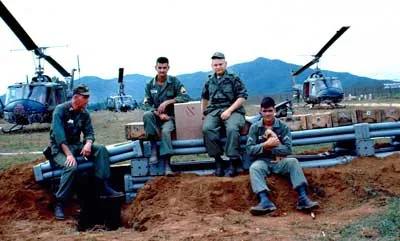
A bunker built by the public information officer section at LZ Dog for visiting media.
It was a perfectly reasonable solution to a real and pressing problem. Naturally, we PIO mandarins decided that it applied to everyone except us.
A few nights later, in the dark of the moon, we dug a chamber beneath the main PIO tent. We scattered excavated soil up and down the busy dirt road 50 feet away, where it soon vanished into the mud. When finished, we had a room about six feet square and eight feet deep and ventilated by a two-foot-square tunnel through a cut above the road, its mouth hidden by shrubbery. In it was our refrigerator. Fifty feet from the tent and six inches below the surface we spliced into an Admin Company power cable.
Access to the room was from beneath the field table Sgt. Mac used as a desk. This sat on one of several wooden pallets used as flooring. Beneath the pallet was a sheet of membrane, and under that a hole and a ladder. In less than a minute, two men could move Mac’s desk, remove the pallet and membrane, descend into the hole, and return with cans of cold comfort.
Not that liquid refreshment was easy to come by. When it came to the simple luxuries of GI life, we were at the mercy of the PX system, which rarely stocked anything in a can and never anything cold. Rare shipments of beer or soda were gone within minutes. For a time, however, before the Army’s logistical system was entirely functional, our PX was supplied through Qui Nhon, the port 40 miles east of An Khe. Goods came ashore on flat-bottomed Navy landing craft and were unloaded on forklifts by GI stevedores. It was sometimes possible to swap a VC flag, a bullet-riddled VC trumpet, or some other war trophy for a few cases of “breakage,” i.e., those accidentally damaged in unloading. I discovered that forklift operators eagerly dumped whole pallets on the beach for something as prized as a blood-stained VC flag.
Such flags were also sewn by local seamstresses and sold in roadside souvenir stands for a dollar or so. For an additional pack of American cigarettes, a Vietnamese might dip it in chicken’s or pig’s blood. And there was at least one factory in town that made VC trumpets. With vigorous haggling, they could be had for five dollars each. We had to shoot our own holes in them, however.
The hard part was finding an excuse to go to Qui Nhon with a truck. But then the Army got its act together and began bringing all PX goods through Saigon’s big port. They were trucked to Tansonnhut and broken down by major units; each got a share of the limited supplies.
Which brings us to the 17th Aviation Company, an “attached” unit based at Plei Ku, about sixty miles west of An Khe. Its mission was logistical support. Every week they flew two twin-engine Caribou transports 300 miles to Tansonnhut to fetch so-called unit morale goods: Zippo lighters, paperback books, razor blades, toothpaste, and, yep, beer and soda. Air Force loadmasters, lords of their lofty domain, had calculated exactly how many 24-can cases a Caribou could hold.
Most Army aviators, however, believe that they are just a skosh smarter than everyone else, especially anyone wearing Air Force Blue. When they learned that loadmasters never actually counted cases, but merely totaled the number of aircraft loads, they realized they could game the system.
A Caribou’s pilots sit side by side, separated by a seven-foot well. At the bottom of the well was the crew chief’s jump seat. They removed the seat and filled the well with cases of beer or soft drinks. The crew chief sat on them for the one-hour hop. Each sortie brought 11 cases of free drinks.
I discovered this nifty scam when returning from Plei Ku. After boarding a Caribou, the crew chief, looking for a source of ice, told me about the beer and soft drinks they scored twice a week, then complained that ice was almost impossible to come by, so they had to drink their looted drinks warm. I described our refrigerator. We made an arrangement: They’d give us two cases of warm and we’d give them one case of cold.
A few days later Capt. Adams entered the PIO tent just as Sergeant Mac popped a Pepsi open. It was a typical day in the highlands jungle, triple-digit temperatures and humidity hovering just below the dew point. Moisture condensed on the frigid can to form enticing droplets as Mac quaffed the sweet, refreshing drink.
“What’s that you’re drinking?” asked Adams, staring at the cold can.
“It’s a Pepsi, sir.”
“It’s a cold Pepsi. Where did you get it?”
Mac took another long swallow, relishing the soothing relief.
“It’s not that cold, sir. More like, well, almost cool.”
He finished the can and crumpled it in his huge fist.
“It looked pretty cold to me,” insisted Adams. “Where did you get a cold drink on a day like this?”
“Told you, sir. It wasn’t so cold.”
“Sergeant, I want to see your refrigerator.”
“What refrigerator is that, sir?”
Adams looked around. There wasn’t much in the tent besides a couple of field tables, a few footlockers, and a file cabinet. He stalked out of the tent.
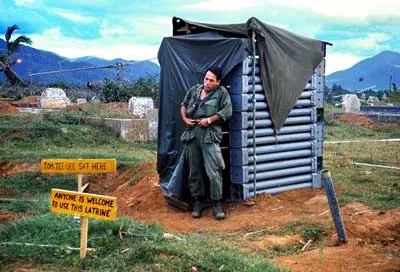
For the next week or so, Adams made a practice of stopping by the PIO tent at odd hours. He never found the fridge, and a few months later, for other reasons, Siler engineered a change of location for our section. We moved a mile down the road, closer to division HQ, no longer in Adams’ fiefdom.
After cold drinks, the rarest commodity in G.I. Vietnam was American-made lumber. Lumber that had been properly cured and wouldn’t warp or split the first time a nail was driven into it. The one time I recall that we actually got our hands on some was by accident. I went with Lightfingers to Qui Nhon in the three-quarter-ton truck on a scrounging mission: I was looking to score photo supplies; he had a list. We drove all over the sprawling Navy base but came up empty-handed. As we rolled toward a shortcut to the An Khe road via the back gate, we spotted a big pile of new two-by-fours sitting next to the road—more unguarded lumber than either of us had seen in Vietnam.
Bill parked on the shoulder and I hopped out. “Let’s don’t be pigs about this,” he said. “Grab about half a dozen and we’re out of here.”
Lightfingers got in the back and I handed boards up to him. We had five on the truck when I heard the siren. I looked up and saw a Shore Patrol jeep, lights flashing and siren wailing, heading up the road straight for us.
“Quick, get up here,” he said.
Then he told me to throw the boards back on the pile. There were only two left when the Shore Patrol arrived. A large, red-faced, beer-bellied chief petty officer came boiling out of the vehicle.
“What the fuck do you think you’re doing?” he bellowed.
Bill stayed cool.
“Just following orders,” he said. “Our first sergeant told us to dump this stuff here, and that’s what we’re doing.”
“In a pig’s eye! You dogfaces don’t come into my house and dump your garbage! Now pick up all that lumber and get it the hell off my base.”
So we took all of it, every last board, and got a Shore Patrol escort off the base and all the way out to Highway 19.
Marvin J. Wolf served 13 years on active duty with the U.S. Army, including eight years as a commissioned officer. He was one of only 60 enlisted and warrant officers to receive a direct appointment to the officer ranks while serving in Vietnam. Wolf has authored more than 20 books, including three about the Vietnam War: “They Were Soldiers,” “Abandoned In Hell,” and “Buddha’s Child.” He lives in Asheville, North Carolina, with his adult daughter and a neurotic, five-pound Chihuahua.
Editors Note: This article first appeared on The War Horse, an award-winning nonprofit news organization educating the public on military service.
 Soldier of Fortune Magazine The Journal of Professional Adventurers
Soldier of Fortune Magazine The Journal of Professional Adventurers


